Book
ISBN: 9783944069067 Year: 2014 Publisher: Köln ad media
Abstract | Keywords | Export | Availability | Bookmark
 Loading...
Loading...Choose an application
- Reference Manager
- EndNote
- RefWorks (Direct export to RefWorks)
In 1994 fib Commission 6: Prefabrication edited a successful Planning and Design Handbook that ran to approximately 45,000 copies and was published in Spanish and German.Nearly 20 years later Bulletin 74 brings that first publication up to date. It offers a synthesis of the latest structural design knowledge about precast building structures against the background of 21st century technological innovations in materials, production and construction. With it, we hope to help architects and engineers achieve a full understanding of precast concrete building structures, the possibilities they offer and their specific design philosophy. It was principally written for non-seismic structures.The handbook contains eleven chapters, each dealing with a specific aspect of precast building structures. The first chapter of the handbook highlights best practice opportunities that will enable architects, design engineers and contractors to work together towards finding efficient solutions, which is something unique to precast concrete buildings. The second chapter offers basic design recommendations that take into account the possibilities, restrictions and advantages of precast concrete, along with its detailing, manufacture, transport, erection and serviceability stages. Chapter three describes the precast solutions for the most common types of buildings such as offices, sports stadiums, residential buildings, hotels, industrial warehouses and car parks. Different application possibilities are explored to teach us which types of precast units are commonly used in all those situations. Chapter four covers the basic design principles and systems related to stability. Precast concrete structures should be designed according to a specific stability concept, unlike cast in-situ structures. Chapter five discusses structural connections. Chapters six to nine address the four most commonly used systems or subsystems of precast concrete in buildings, namely, portal and skeletal structures, wall-frame structures, floor and roof structures and architectural concrete facades. In chapter ten the design and detailing of a number of specific construction details in precast elements are discussed, for example, supports, corbels, openings and cutouts in the units, special features related to the detailing of the reinforcement, and so forth. Chapter eleven gives guidelines for the fire design of precast concrete structures. The handbook concludes with a list of references to good literature on precast concrete construction. [Publisher]
691.328 --- 691.3 --- 624.012.46 --- 693.56 --- bouwkunde --- beton --- montagebouw --- betonconstructies --- 693.56 Prestressed concrete construction --- Prestressed concrete construction --- 624.012.46 Structures in prestressed concrete --- Structures in prestressed concrete --- 691.3 Artificial stone. Concrete. Various agglomerates --- Artificial stone. Concrete. Various agglomerates --- 691.328 Reinforced concrete. Prestressed concrete. Reinforced concrete elements --- Reinforced concrete. Prestressed concrete. Reinforced concrete elements --- PXL-Tech 2016
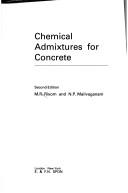
Abstract | Keywords | Export | Availability | Bookmark
 Loading...
Loading...Choose an application
- Reference Manager
- EndNote
- RefWorks (Direct export to RefWorks)
Concrete --- -691.3 --- 624.012.4 --- Beton --- Building materials --- Additives --- Artificial stone. Concrete. Various agglomerates --- Structures in concrete, in-situ concrete (ordinary concrete), mass concrete --- Additives. --- 624.012.4 Structures in concrete, in-situ concrete (ordinary concrete), mass concrete --- 691.3 Artificial stone. Concrete. Various agglomerates --- 691.3 --- Concrete admixtures
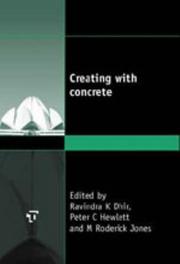
ISBN: 0727728334 Year: 1999 Publisher: London Telford
Abstract | Keywords | Export | Availability | Bookmark
 Loading...
Loading...Choose an application
- Reference Manager
- EndNote
- RefWorks (Direct export to RefWorks)
666.97 --- 691.3 --- Concrete --- Concrete construction --- Building, Concrete --- Concrete building --- Construction, Concrete --- Building --- Beton --- Building materials --- Mortar and concrete industry. Concrete elements. Factory production of concrete --- Artificial stone. Concrete. Various agglomerates --- 691.3 Artificial stone. Concrete. Various agglomerates --- 666.97 Mortar and concrete industry. Concrete elements. Factory production of concrete
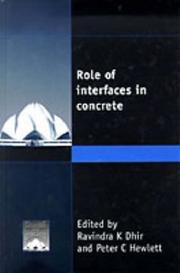
ISBN: 0727728180 Year: 1999 Publisher: London Telford
Abstract | Keywords | Export | Availability | Bookmark
 Loading...
Loading...Choose an application
- Reference Manager
- EndNote
- RefWorks (Direct export to RefWorks)
666.97 --- 691.3 --- Concrete --- Interfaces (Physical sciences) --- Surface chemistry --- Surfaces (Physics) --- Beton --- Building materials --- Mortar and concrete industry. Concrete elements. Factory production of concrete --- Artificial stone. Concrete. Various agglomerates --- 691.3 Artificial stone. Concrete. Various agglomerates --- 666.97 Mortar and concrete industry. Concrete elements. Factory production of concrete
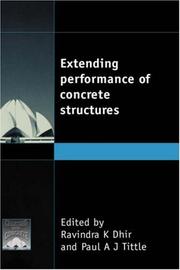
ISBN: 0727728202 Year: 1999 Publisher: London Telford
Abstract | Keywords | Export | Availability | Bookmark
 Loading...
Loading...Choose an application
- Reference Manager
- EndNote
- RefWorks (Direct export to RefWorks)
666.97 --- 691.3 --- Concrete construction --- Reinforced concrete --- Ferrocement --- Structural concrete --- Building materials --- Concrete --- Building, Concrete --- Concrete building --- Construction, Concrete --- Building --- Mortar and concrete industry. Concrete elements. Factory production of concrete --- Artificial stone. Concrete. Various agglomerates --- 691.3 Artificial stone. Concrete. Various agglomerates --- 666.97 Mortar and concrete industry. Concrete elements. Factory production of concrete
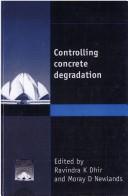
ISBN: 0727728199 Year: 1999 Publisher: London Telford
Abstract | Keywords | Export | Availability | Bookmark
 Loading...
Loading...Choose an application
- Reference Manager
- EndNote
- RefWorks (Direct export to RefWorks)
691.3 --- 666.97 --- Concrete --- -Beton --- Building materials --- Artificial stone. Concrete. Various agglomerates --- Mortar and concrete industry. Concrete elements. Factory production of concrete --- Deterioration --- -Artificial stone. Concrete. Various agglomerates --- 666.97 Mortar and concrete industry. Concrete elements. Factory production of concrete --- 691.3 Artificial stone. Concrete. Various agglomerates --- -666.97 Mortar and concrete industry. Concrete elements. Factory production of concrete --- Beton
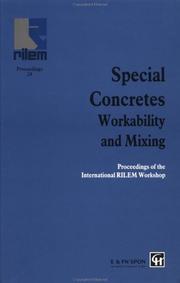
ISBN: 0419188703 9781482271379 1482271370 020362663X 9780203626634 0203630521 9780203630525 9780419188704 Year: 1994 Publisher: London Spon
Abstract | Keywords | Export | Availability | Bookmark
 Loading...
Loading...Choose an application
- Reference Manager
- EndNote
- RefWorks (Direct export to RefWorks)
Concrete --- -Concrete --- -691.3 --- 624.012.4 --- #KVIV:BB --- Beton --- Building materials --- Testing --- -Congresses --- Mixing --- Artificial stone. Concrete. Various agglomerates --- Structures in concrete, in-situ concrete (ordinary concrete), mass concrete --- Congresses. --- 624.012.4 Structures in concrete, in-situ concrete (ordinary concrete), mass concrete --- 691.3 Artificial stone. Concrete. Various agglomerates --- 691.3 --- Mixing&delete& --- Congresses --- Testing&delete&
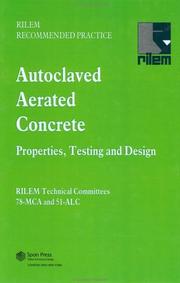
Abstract | Keywords | Export | Availability | Bookmark
 Loading...
Loading...Choose an application
- Reference Manager
- EndNote
- RefWorks (Direct export to RefWorks)
Lightweight concrete --- #KVIV:BB --- 691.3 --- 624.012.4 --- Cellular concrete --- Concrete, Lightweight --- No-fines concrete --- Pervious concrete --- Porous concrete --- Concrete --- Artificial stone. Concrete. Various agglomerates --- Structures in concrete, in-situ concrete (ordinary concrete), mass concrete --- Lightweight concrete. --- 624.012.4 Structures in concrete, in-situ concrete (ordinary concrete), mass concrete --- 691.3 Artificial stone. Concrete. Various agglomerates
Book
ISBN: 9782910342869 2910342867 Year: 2013 Publisher: Paris Ed. du Linteau
Abstract | Keywords | Export | Availability | Bookmark
 Loading...
Loading...Choose an application
- Reference Manager
- EndNote
- RefWorks (Direct export to RefWorks)
The invention of cement revolutionized construction and civil engineering. It is not - as one might think - from the brain of a diploma engineer, but the experience of a gardener. As it was the fashion, there was rock throwing of cement on a fence. He observed that this material was both waterproof and rot proof and used it in place of wooden flower boxes. Noticing that this material had a high resistance, it was used for bins, first small then large, then tanks, soon beams, bridges ... The book traces the history of this slow development which was carried out over a dozen years, as well as trial and error and achievements of other researchers, in France, the United States, Great Britain and Germany.
Reinforced concrete --- Monier, Joseph, --- Béton armé --- Ingénieurs --- 624.012.45 --- 691.3 --- 691.3 Artificial stone. Concrete. Various agglomerates --- Artificial stone. Concrete. Various agglomerates --- 624.012.45 Structures in reinforced concrete. Ferro-concrete structures --- Structures in reinforced concrete. Ferro-concrete structures --- Engineers --- History. --- Biography. --- Histoire --- Biographies --- Reinforced concrete construction --- Designs and plans.
Book
Abstract | Keywords | Export | Availability | Bookmark
 Loading...
Loading...Choose an application
- Reference Manager
- EndNote
- RefWorks (Direct export to RefWorks)
691.3 --- 624.012.4 --- 666.97 --- 666.97 Mortar and concrete industry. Concrete elements. Factory production of concrete --- Mortar and concrete industry. Concrete elements. Factory production of concrete --- 624.012.4 Structures in concrete, in-situ concrete (ordinary concrete), mass concrete --- Structures in concrete, in-situ concrete (ordinary concrete), mass concrete --- 691.3 Artificial stone. Concrete. Various agglomerates --- Artificial stone. Concrete. Various agglomerates

 Search
Search Feedback
Feedback About
About Help
Help News
News